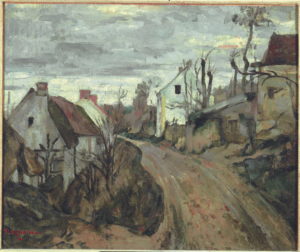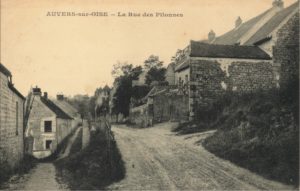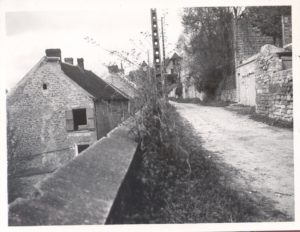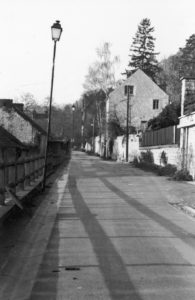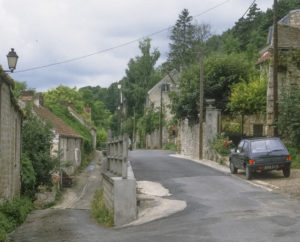R191 La Vieille Route à Auvers-sur-Oise (rue des Pilonnes) II 1872-1873 (FWN69)
{R190 – La Vieille Route à Auvers-sur-Oise (rue des Pilonnes) I 1872-1873 (FWN68)}
Pavel Machotka
(Cliquer sur l’image pour l’agrandir)
A mere two years after painting La Neige fondue à l’Estaque and settled near Pissarro in Auvers, northwest of Paris, Cézanne paints a scene that may at first indicate a comparably somber mood, but in fact we find the mood in the landscape.
Somber skies are far from atypical in Auvers, and finding one as grey as the one in the painting is not at all difficult. Seeing the actual site – and later comparing it with the older postcard[1] — one loses the sense of the passage of time; except for the cars and the evidence of electricity, one could be in the nineteenth century. And as the motif is experienced in the present, so one feels the painter to be present in his composition. The brush strokes are short and controlled, and there is a pronounced interest in space. The steep, twisted bank to the road’s left – a kind of warp that Cézanne finds often in Auvers – introduces us to the picture’s depth. It follows along the receding road but slows it down, to prevent too abrupt a flight toward the most distant point; and at that point Cézanne lightens the road’s color and brings it back toward us. In the exact center, Cézanne highlights the corner of the house with a streak of yellow, anchoring and centering our vision. By this emphasis, then, he gives us in effect both a dynamic space and a stabilized composition.
Pavel Machotka, Cézanne: Landscape into art.
Autre version de ce tableau :
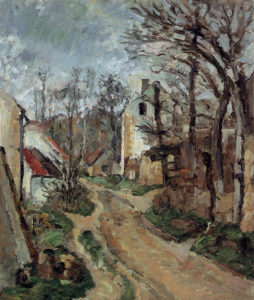
Cezanne, La Vieille Route à Auvers-sur-Oise (rue des Pilonnes) I
1872-1873
55 x 46 cm)
R190 FWN68
[1] M. Alain Mothe has brought together period photographs of many of the sites that Cézanne painted in Auvers and Pontoise (and elsewhere), thus establishing their identity and providing a vivid picture of the texture and appearance of the region. See Ce Que voyait Cézanne for the photograph of La Vieille route, p. 22, and consult his Cézanne à Auvers-sur-Oise for a history of Cézanne’s work there.

